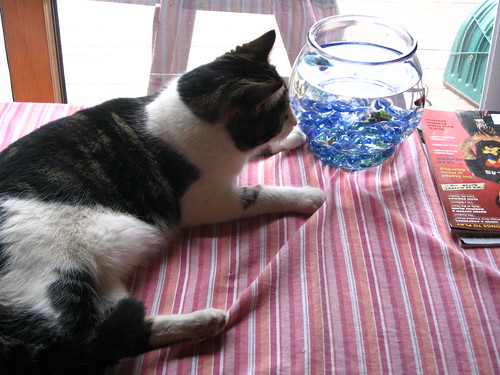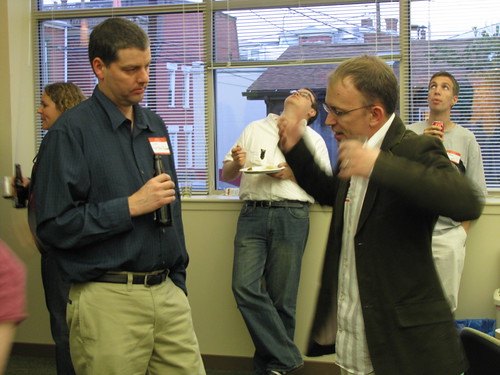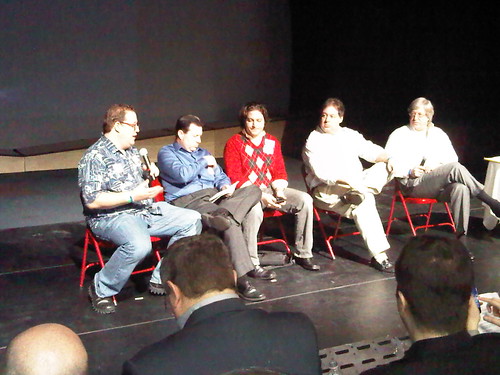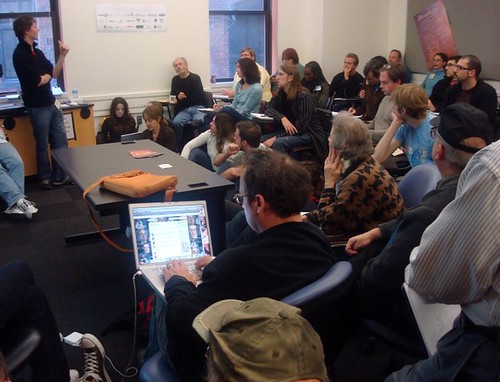Although
PodCamp Pittsburgh 3 is a free event, we decided to offer this year's attendees the opportunity to pre-register as VIPs. The perks of being a PCPGH VIP -- in addition to having a lot of abbreviations to throw around -- include some advance notoriety (i.e., a listing here), a swag bag and a free PCPGH3 t-shirt.
Following are the profiles of some of our PCPGH3 VIPs -- namely, the ones who wanted to take advantage of the opportunity to get some extra exposure for themselves and their work. (Those who didn't must only be coming for the free t-shirts...)
PCPGH 3 VIPs (Listed Alphabetically by Last Name) Aaron Aiken
Aaron Aiken (
Twitter)
Aaron is a Web 2.0 junkie who will jump on any bandwagon offering private beta invites. He is passionate about personal finances and happens to write a blog on the subject with his wife, Lindsay. He writes to fulfill his passion and dreams of writing full-time one day. Aaron believes strongly that change can only come if one is willing to grow. His advice (to anyone who does not ask for it): “Track your spending for the next 30 days and get on a budget.”
* Areas of expertise: Writing, creativity, learning, and his Blackberry Curve 8310
* Areas he'd like to learn more about: Podcasting, getting more traffic to our site and developing repeat visits, growing a community, and using social media to raise awareness of our website.
********
 Lindsay Aiken
Lindsay AikenLindsay is a full-time nanny and part-time college student studying Massage Therapy. When she’s not working, she enjoys writing for her personal finance blog that she maintains with her husband, Aaron. She hopes that their blog will be useful to other people their age, helping to teach them the importance of properly managing their money so they will be prepared for the future.
* Areas of expertise: Writing, creative organization, and frugal living
********
 Kathleen Danielson
Kathleen Danielson (
Twitter)
"I am a college student just learning about social media. I'm eager to learn more about the way information spreads online and how people connect and develop relationships using different tools across the web. I'm studying International Affairs at George Washington University, concentrating in Global Public Health. Hopefully, I'll eventually be able to combine my passion for international affairs with my passion for social media."
* Areas of interest: viral marketing, social networking, human interaction, lolcats, video, blogging, building community, evangelizing web 2.0
********
 Megan Engle
Megan Engle (
Twitter)
Megan is the Social Media Manager at the
Michigan Nonprofit Association, and is currently working on revamping the
MNA blog. She enjoys exploring new ways to cook vegetarian food, polishing her near-extinct Arabic skills, and figuring out what's going on in the world of social media.
Outside of work, Megan can generally be found walking her chocolate lab Mort, sporting a Kentucky Wildcats t-shirt, thinking about whether she passed the Michigan Bar Exam, and mourning the loss of The Wire, which she thinks may possibly be one of the greatest television shows, ever.
* Areas she'd like to learn more about: blogging, audio (podcasting), video, social networking, and ways for nonprofits to use social media.
********
 Shawn Farner
Shawn Farner (
Twitter)
Shawn Farner is a senior at IUP with an unhealthy passion for both social media and community service. After his December graduation, he hopes to work for a web startup or for a business trying to establish a social media presence.
********
 Tim Grubb
Tim Grubb (
Twitter)
Tim podcasts with Jen Sadler on
Brain Gravy and insists, "We're not alcoholics with a drinking problem, we're Alcohol Enthusiasts with a podcasting problem."
********
 Tim Hindes
Tim Hindes,
Pittsburgh Tech Council (
Twitter)
In his current position, Tim oversees all aspects of marketing and communications efforts for the
Pittsburgh Technology Council -- one of the sponsors of PCPGH3. Tim's job focuses primarily on electronic media and strategic communications. In addition, he was responsible for project management of the Council’s new
Web site, dedicated to highlighting membership benefits, member profiles, case studies, new products and added services. Strategic planning, brand development and marketing partnership relations were additional areas of Tim’s responsibility. While at the PTC, he developed other viral marketing media, including social marketing channels,
blogs and interactive networking groups. His communication plan helped earn the Council the ASAE Gold Circle Award - Honorable Mention, in 2007, for electronic communications.
Based upon his marketing expertise, Tim also serves on two advisory boards including the Business Administration Advisory Committee for Pittsburgh Technical Institute and the Sales & Marketing Network Advisory Board of the Pittsburgh Technology Council. Tim is a 2000 cum laude graduate of Allegheny College in Meadville, PA, with a bachelor’s degree in Communication Arts and a minor in Society, Art and Science. He currently resides in the South Hills of Pittsburgh, PA.
* Areas of expertise: Marketing, Blogging, Lead Generation, Social Media Strategy
* Areas he'd like to learn more about: Networking, More Blogging, SEO, Podcasting, Business Usage
********
 Blake Imeson
Blake Imeson (
Twitter)
Blake is a junior at Grove City College, working on a degree in Entrepreneurship. Blake does part-time SEO and Social Media consulting. Connect with him on
LinkedIn.
* Areas of expertise: SEO, Blogging and Social Media
* Areas he'd like to learn more about: He is a huge fan of Wordpress and Firefox.
********
Alan Jakub (
Twitter)
Alan is a Web Designer with experience in WordPress, Podcasting -&- Graphic Design He's also online at
Dr-T.
********
 Julie Morey
Julie Morey,
ElasticLab (
Twitter)
Julie Morey is currently the Chief Creative Officer at ElasticLab -- one of the sponsors of PCPGH3. In 30 years as a designer, art director and brand strategist, Julie’s work for brands like Vehix, AT&T, Quiznos, Nextel, Herman Miller, American Express, Nordica and Public Television has resulted in both dramatic results and creative recognition. With a strong background in commercial production, a mid-career opportunity to lead creative efforts promoting a spirit of ethnic diversity for AT&T, MTV, HBO and TBS has fueled Julie’s love of the social medium. In 2007, she began developing Elastic Lab with a firm belief in the creative future of film and new media. Julie has earned more than 150 awards including the One Show, Communication Arts, Clios, and International Broadcasting Association (IBA).
* Areas of expertise: brand design, film production, advertising
* Areas she'd like to learn more about: music, new technologies, blogging
********
 Melody Platz
Melody Platz* Areas of expertise: Travel writing, maintaining multiple blogs and creative writing
* Areas of interest: Humor, History, Eating, Science, Good Friends and Sleeping
********
 Walt Ribeiro
Walt Ribeiro (
Twitter)
Walt Ribeiro's "in your face" teaching style has created an entire community of those interested in music or not. "The Internet's Music Teacher" has consistently created a fleet of dedicated viewers, and shares his lessons, passion, and knowledge of music (and more) everyday. Ribeiro now teaches music lessons full-time online as "Your Daily Music Lesson with Walt" for sites like Revision 3, Ustream.TV, and more.
* Areas of expertise = The Internet's Music Teacher, Social Media marketing, Orchestration
* Areas he'd like to learn more about = Networking, production, distribution, marketing
********
 Jen Sadler
Jen Sadler (
Twitter)
Jen is a Podcaster/Freelance Social Media Consultant from Essex, Ontario, Canada. She podcasts at
Brain Gravy.
********
 Scott Tyler
Scott TylerA
beer geek and snob extraordinaire...
********
Come meet these fine folks and hundreds more at
PodCamp Pittsburgh 3 on October 18-19!
Labels: blogging, events, liveevent, pcpgh, pcpgh3, pittsburgh, podcamp, podcamppittsburgh, podcasting, social media, social networking
 On Tuesday, May 5, I'll be conducting a pair of workshops at the Business Smart Tools Conference in Stamford, CT. The subjects I'll be covering are the two I spend the most time with online: video and Twitter, both in terms of business use.
On Tuesday, May 5, I'll be conducting a pair of workshops at the Business Smart Tools Conference in Stamford, CT. The subjects I'll be covering are the two I spend the most time with online: video and Twitter, both in terms of business use.






























